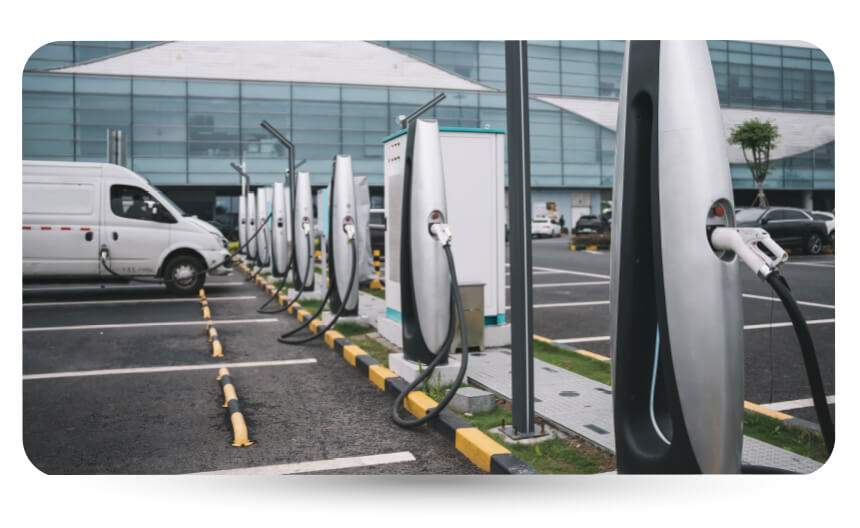Benefits of Installing Workplace Electrical Vehicle Charging
07/05/2025 00:00:00by Mark McKenna07/05/2025 00:00:00Benefits of Installing Workplace Electrical Vehicle ChargingBluedrop Services
As electric vehicles (EVs) become increasingly popular, businesses have a unique opportunity to support sustainability while enhancing their workplace offerings by installing EV charging stations. Fleet Insurance Brokers, Bluedrop Services, explain how workplace charging not only benefits employees who drive EVs but also positions your company as a forward-thinking, environmentally conscious organisation.

Here’s a closer look at the advantages of investing in EV charging infrastructure for your workplace.
Supporting Sustainability Goals
Installing EV charging stations aligns with corporate social responsibility (CSR) initiatives and sustainability goals. Encouraging the use of EVs reduces greenhouse gas emissions and helps combat climate change. By providing charging facilities, your business actively promotes the shift toward cleaner transportation.
Attracting and Retaining Talent
Employees increasingly value companies that prioritise environmental stewardship and innovative amenities. Offering workplace charging can make your organisation more appealing to eco-conscious employees. It also shows your commitment to supporting your workforce's needs, fostering loyalty and satisfaction.
Enhancing Your Company’s Image
Workplace charging infrastructure signals that your company is progressive, innovative, and environmentally responsible. This can enhance your reputation with clients, partners, and the local community. It may also attract environmentally focused investors who value green initiatives.
Incentivising EV Adoption Among Employees
Many employees hesitate to switch to EVs due to concerns about charging accessibility. By providing charging stations at work, you help alleviate "range anxiety" and make EV ownership more feasible. This support can encourage employees to make the transition to electric vehicles.
Financial Incentives and Cost Savings
Governments and local authorities often provide grants, tax credits, or subsidies to businesses installing EV charging stations. Additionally, some regions offer reduced energy costs for off-peak charging. Over time, investing in workplace charging can yield significant cost savings while leveraging these financial incentives.
Potential Insurance Savings
This infrastructure encourages the use of electric vehicles (EVs) over personal cars (grey fleet), which not only reduces the environmental impact but also enhances safety, as modern EVs are equipped with advanced safety features like automatic emergency braking and lane-keeping assistance. By shifting to a company-owned electric fleet, businesses can minimise reliance on personal vehicles, leading to fewer insurance claims related to grey fleet usage and potentially lower fleet insurance premiums.
Increasing Property Value
Adding EV charging infrastructure can increase the overall value of your commercial property. As the demand for EVs rises, buildings equipped with charging facilities will likely become more desirable for tenants and buyers, providing a competitive edge in the real estate market.
Compliance with Emerging Regulations
Many countries are implementing policies to phase out fossil fuel-powered vehicles and encourage EV adoption. Future regulations may mandate businesses to provide EV charging facilities. Installing chargers now prepares your business for potential regulatory changes and avoids last-minute compliance challenges.
Boosting Employee Productivity
Convenient workplace charging allows employees to focus on their work without worrying about finding charging points during the day. This reduces stress and boosts productivity, as employees can efficiently charge their vehicles while they work.
How to Implement Workplace Charging
1. Assess Demand and Needs
Survey employees to understand current and future demand for EV charging. Consider the number of EVs in use and anticipated growth.
2. Choose the Right Charging Stations
Select chargers based on the expected usage - Level 2 chargers are typically suitable for workplace environments as they balance charging speed and cost.
3. Leverage Incentives
Research local and national programs offering financial support for EV charging installation to offset costs.
4. Develop a Usage Policy
Create guidelines for charger use, such as time limits or priority access for EV drivers, to ensure fairness and accessibility.
5. Promote Your Initiative
Communicate the availability of workplace charging to employees and use it as a selling point when recruiting new talent.
Conclusion
Installing workplace charging for EVs is a smart investment that benefits businesses, employees, and the environment. It supports sustainability goals, enhances your brand’s image, and provides a valuable amenity for employees. By taking proactive steps to integrate EV charging infrastructure, your company can position itself as a leader in the green energy transition while enjoying tangible economic and reputational benefits.
Return to blog menuWant to find out more about Bluedrop's Fleet Insurance?
Call our friendly team now for the right insurance cover - at the best price
+441489780491
Calls recorded for training and quality.



 Privacy and Cookie Policy
Privacy and Cookie Policy